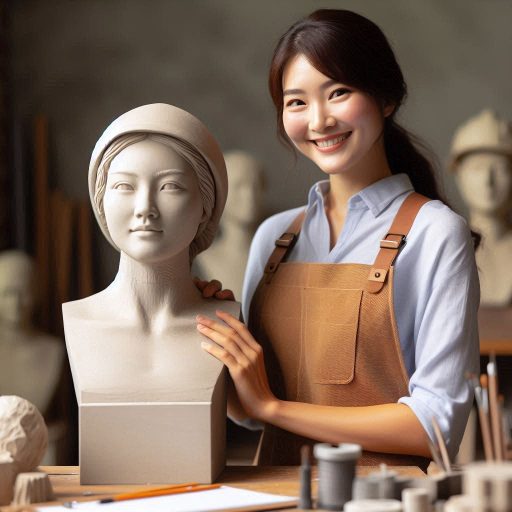Introduction
Art careers often involve a delicate dance between creativity and commerce.
Many artists passionately pursue their craft, driven by inspiration and expression.
However, the reality of sustaining an art career frequently demands financial considerations.
Finding a balance between artistic fulfillment and financial stability is crucial.
Artists must navigate the challenge of making a living while staying true to their creative vision.
This balance helps prevent burnout and disillusionment, which can stifle creativity.
Financial stability allows artists to invest in their materials, education, and promotion.
It also provides the freedom to experiment and take risks.
When artists prioritize commerce, they may compromise their creativity for the sake of profits.
Conversely, focusing solely on artistic expression can lead to financial strain and insecurity.
Understanding the art market is essential for artists seeking this balance.
They should explore various revenue streams, such as commissions, sales, and grants.
Additionally, marketing skills play a vital role in promoting their work and reaching potential buyers.
Ultimately, a successful art career thrives on the interplay between creativity and commerce.
Artists who find this balance can create meaningful work while ensuring their financial well-being.
By doing so, they contribute to a vibrant cultural landscape while securing their future in the arts.
Understanding the Intersection
How creativity and commerce intersect in art careers
Creativity and commerce intersect in art careers, shaping how artists create and sell their work.
Artists often strive to express their unique visions while meeting market demands.
This balancing act is crucial for sustaining a career in art.
Many artists initially focus on their creative impulses.
Transform Your Career Today
Unlock a personalized career strategy that drives real results. Get tailored advice and a roadmap designed just for you.
Start NowThey want to produce meaningful work that resonates with audiences.
However, as they develop their careers, they encounter commercial realities.
These realities can dictate trends, styles, and pricing.
Artists must navigate this complex landscape to thrive.
Challenges artists face when trying to balance the two aspects
One challenge artists face is the pressure to conform to market expectations.
Clients and galleries often seek what sells rather than what inspires.
This pressure can stifle creativity and lead to frustration.
Artists may feel torn between their passion and financial stability.
Additionally, artists must understand marketing strategies.
They need to promote their work effectively to gain visibility.
This often requires skills outside of their artistic expertise, such as social media management and branding.
Learning these skills can be overwhelming, especially for those focused solely on their craft.
Financial instability is another significant challenge.
Many artists struggle to secure steady income from their work.
They may rely on commissions, grants, or side jobs to make ends meet.
This can detract from their creative time and energy, forcing them to prioritize commerce over creativity.
Despite these challenges, finding a balance is essential.
Successful artists often embrace both aspects, allowing creativity to inform their business decisions.
By integrating artistry with strategic planning, they can cultivate fulfilling and sustainable careers.
Ultimately, understanding this intersection empowers artists to navigate their unique paths in the art world.
Transform Your Career Today
Unlock a personalized career strategy that drives real results. Get tailored advice and a roadmap designed just for you.
Start NowRead: Art and Design Portfolios: Creating a Standout
Identifying Personal Goals
When pursuing a career in art, it is essential for artists to understand their personal goals and values.
By reflecting on what they hope to achieve and what is most important to them, artists can better navigate the delicate balance between creativity and commerce.
Self-Reflection
- Encourage artists to take the time to reflect on their personal goals and values.
- Ask questions such as: What drives your passion for art? What are your long-term aspirations?
- Understanding what truly matters to you can help guide your decision-making process.
Priorities and Balance
- Discuss how individual priorities can significantly impact the balance between creativity and commerce.
- Some artists may prioritize artistic freedom and expression over financial success.
- Others may view commercial success as a means to fund their creative endeavors.
- Finding the right balance that aligns with your personal goals is key to a fulfilling art career.
Ultimately, each artist’s journey is unique, and there is no one-size-fits-all approach to balancing creativity and commerce.
By identifying personal goals and values, artists can make informed decisions that support their artistic vision while also achieving financial stability.
Read: Glass Art Courses: What to Expect
Developing a Business Mindset
Importance of Understanding the Business Side of Art Careers
Artists often focus solely on their craft, neglecting the business aspect of their careers.
However, understanding the business side of art careers is essential for long-term success and sustainability.
By developing a business mindset, artists can better navigate the industry, make informed decisions, and secure profitable opportunities.
Tips on Improving Financial Literacy and Strategic Planning Skills
- Take online courses or workshops on financial management and business strategies.
- Read books or articles on entrepreneurship, marketing, and financial planning.
- Seek advice from mentors or professionals in the art and business industries.
- Create a budget and financial plan to track income, expenses, and savings.
- Set short-term and long-term goals to guide your artistic and financial growth.
Read: Digital Sculpting: Combining Art with Technology

Navigating the Market
When it comes to navigating the market in art careers, artists must understand the role of market trends and consumer preferences.
Understanding Market Trends
Artists need to stay informed about current market trends to ensure their work remains relevant.
Market trends can influence the demand for specific styles, themes, and mediums in the art world.
Artists should pay attention to emerging artists, galleries, and art fairs to gauge what is popular in the market.
Adapting to Consumer Preferences
Consumer preferences play a significant role in shaping the market for art and influencing purchasing decisions.
Artists should research their target audience to understand what appeals to potential buyers and collectors.
Flexibility is key in adapting to changing consumer preferences while still staying true to one’s artistic vision.
While it’s important to be aware of market trends and consumer preferences, artists should also prioritize staying true to their creative vision.
Staying True to Creative Vision
Artists should not compromise their artistic integrity for the sake of commercial success.
It’s essential to create work that is authentic and meaningful to the artist, regardless of market demands.
Transform Your Career Today
Unlock a personalized career strategy that drives real results. Get tailored advice and a roadmap designed just for you.
Start NowFinding a balance between personal expression and marketability is crucial for long-term success in an art career.
Ultimately, artists can navigate the market by finding ways to adapt to market trends and consumer preferences while remaining faithful to their artistic vision.
Read: Art and Design Trends in 2024: What‘s Hot?
Collaborating with Others
Benefits of collaborating with other artists, galleries, and businesses
- Collaboration can bring fresh perspectives and ideas to your work.
- Networking opportunities can arise from collaborations with other artists and galleries.
- Collaborating with businesses can help artists reach a wider audience and increase sales.
- Sharing resources and skills can result in more innovative and impactful projects.
How partnerships can help artists achieve a balance between creativity and commerce
- Partnerships can provide financial support for artistic projects.
- Collaborating with galleries can help artists showcase their work to a larger audience.
- Business partnerships can lead to profitable opportunities for artists.
- Working with others can reduce the burden of administrative tasks, allowing artists to focus on their creativity.
In general, collaborating with others in the art world can open up new opportunities, enhance creativity, and help artists strike a balance between their artistic vision and the practical aspects of running a successful career in the arts.
Managing Time and Resources
Strategies for artists to effectively manage their time and resources
- Use a planner or calendar to schedule tasks efficiently.
- Prioritize important projects over less urgent ones.
- Set specific goals and deadlines for each task.
- Allocate time for creative work, marketing, and administrative tasks.
Effective time management is crucial for artists juggling various responsibilities.
By creating a schedule and sticking to it, artists can ensure they have dedicated time for creative pursuits, business tasks, and personal activities.
Importance of setting priorities and establishing a sustainable work-life balance
- Identify the most important tasks that align with your artistic goals.
- Learn to say no to distractions or projects that do not contribute to your growth.
- Establish boundaries to protect your personal time and mental well-being.
- Take breaks and practice self-care to prevent burnout and maintain creativity.
Artists often struggle with balancing their artistic endeavors with the demands of running a business.
By setting clear priorities and boundaries, artists can streamline their workflow and ensure they are making progress towards their goals without sacrificing their well-being.
Gain More Insights: Building Relationships with Clients as a Creative Director
Seeking Mentorship and Feedback
Mentorship and feedback are essential components for artists looking to establish a successful career in the art world.
By seeking guidance from experienced professionals, artists can gain valuable insights and perspectives that can help them navigate the complexities of balancing creativity and commerce.
The Benefits of Mentorship
One of the key benefits of mentorship is the opportunity for artists to learn from someone who has already walked the path they aspire to follow.
Mentors can provide valuable advice on how to develop their artistic skills, build a portfolio, and make strategic decisions that will help them succeed in the competitive art market.
Furthermore, mentors can offer valuable feedback on an artist’s work, helping them identify areas for improvement and refine their artistic vision.
This feedback can be invaluable for artists looking to grow and evolve in their practice, as it can help them see their work from a different perspective and push them to explore new ideas and techniques.
Building a Support System
Seeking mentorship also allows artists to build a strong support system within the art community.
By developing relationships with experienced professionals, artists can gain access to a network of contacts and resources that can help them advance their career.
Mentors can also provide guidance on how to navigate the challenges and opportunities that come with pursuing a career in art, offering insights based on their own experiences in the field.
Moreover, mentorship can help artists develop a sense of accountability and discipline in their practice.
By setting goals and receiving feedback from a mentor, artists can stay motivated and focused on their creative and professional development.
Transform Your Career Today
Unlock a personalized career strategy that drives real results. Get tailored advice and a roadmap designed just for you.
Start NowThis sense of structure can be essential for artists looking to balance the demands of creativity and commerce, as it can help them stay organized and on track towards achieving their artistic goals.
Embracing Feedback
In addition to seeking mentorship, artists should also be open to receiving feedback from a variety of sources.
Constructive criticism can help artists refine their work and make it more appealing to a wider audience.
By listening to feedback from collectors, gallerists, and other artists, artists can gain valuable insights into how their work is perceived and how it can be improved to better meet the needs and expectations of their audience.
Furthermore, feedback can help artists develop a thicker skin and learn to accept rejection as a part of the creative process.
Not every piece of art will resonate with every viewer, and artists must be prepared to accept criticism and use it as an opportunity for growth and learning.
By embracing feedback and viewing it as a tool for improvement, artists can develop a more resilient and adaptable approach to their practice, allowing them to thrive in an ever-changing art market.
In a nutshell, seeking mentorship and feedback are essential strategies for artists looking to balance creativity and commerce in their art careers.
By learning from experienced professionals and being open to feedback, artists can develop the skills, insights, and support they need to succeed in the competitive and dynamic world of art.
Find Out More: Salary Expectations for Product Designers in the USA
Conclusion
Finding the balance between creativity and commerce is essential for artists.
It is crucial to understand that while creating art is a passion, it is also a career that requires financial stability.
Embracing this challenge can lead to a fulfilling and successful art career.
Ultimately, artists must strive to create work that is both artistically satisfying and commercially viable.
By understanding the market, building a strong brand, and developing business skills, artists can navigate the complexities of the art world while staying true to their creative vision.
It’s important for artists to recognize that there is value in their work and to be open to exploring new opportunities for growth and profitability.
By embracing the challenge of balancing creativity and commerce, artists can establish themselves as successful professionals in the art industry.
I encourage artists to take on the challenge of finding that sweet spot where creativity and commerce intersect.
By doing so, artists can pave the way for a sustainable and rewarding career in the ever-evolving world of art.
[E-Books for Sale]
The Big Book of 500 High-Paying Jobs in America: Unlock Your Earning Potential
$19.99 • 500 High-Paying Jobs • 330 pages
Explore 500 high-paying jobs in America and learn how to boost your career, earn more, and achieve success!
See All 500 High-Paying Jobs of this E-Book
1001 Professions Without a Degree: High-Paying American Jobs You Can Start Now
$19.99 • 1001 Professions Without a Degree • 174 pages
Discover 1001 high-paying jobs without a degree! Unlock career tips, skills, and success strategies for just $19.99!




